brake fluid PONTIAC GRAND-PRIX 1993 Owners Manual
[x] Cancel search | Manufacturer: PONTIAC, Model Year: 1993, Model line: GRAND-PRIX, Model: PONTIAC GRAND-PRIX 1993Pages: 338, PDF Size: 17.3 MB
Page 108 of 338
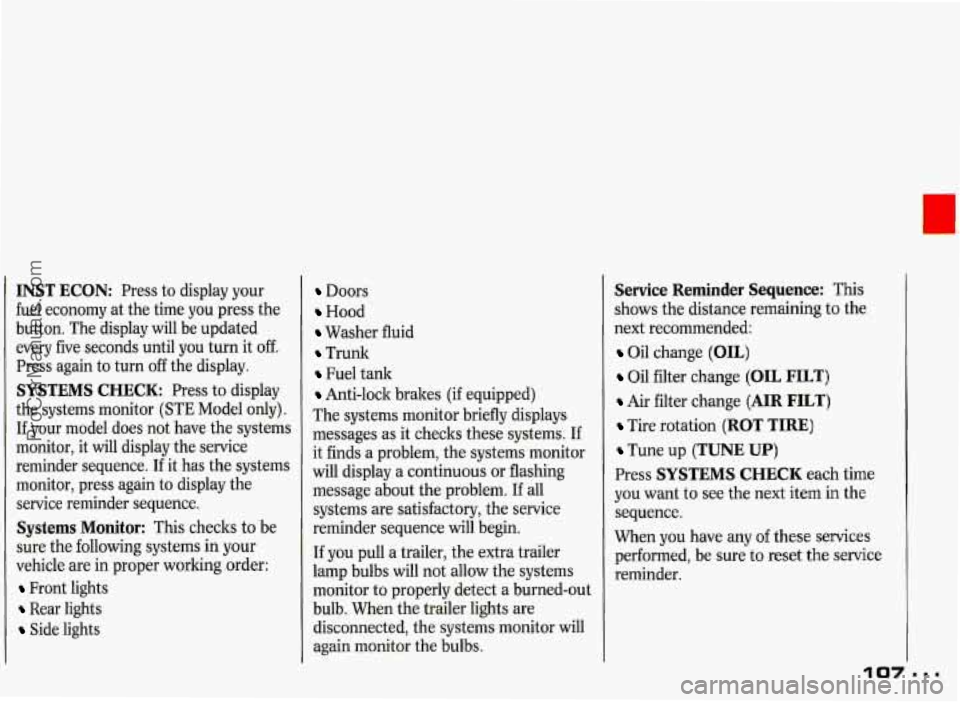
INST ECON: Press to display your
fuel economy at the time you press the
button. The display will be updated
every five seconds until you turn it off.
Press again to turn off the display.
SYSTEMS CHECK: Press to display
the systems monitor
(STE Model only).
If your model does not have the systems
monitor, it will display the sewice
reminder sequence.
If it has the systems
monitor, press again to display the
service reminder sequence.
Systems Monitor: This checks to be
sure the following systems in your
vehicle are in proper working order:
Front lights
Rear lights
Side lights
Doors
Hood
Washer fluid
Trunk
Fuel tank
Anti-lock brakes (if equipped)
The systems monitor briefly displays
messages as it checks these systems. If
it finds a problem, the systems monitor
will display a continuous
or flashing
message about the problem. If all
systems are satisfactory, the service
reminder sequence will begin.
If you pull a trailer, the extra trailer
lamp bulbs will not allow the systems
monitor to properly detect a burned-out
bulb. When the trailer lights are
disconnected, the systems monitor will
again monitor the bulbs.
Service Reminder Sequence: This
shows the distance remaining to the
next recommended:
Oil change (OIL)
Oil filter change (OIL FILT)
Air filter change (AIR FILT)
Tire rotation (ROT TIRE)
Tune up (TUNE UP)
Press SYSTEMS CHECK each time
you want to see the next item in the
sequence.
When you have any of these services
performed, be sure to reset the service
reminder.
ProCarManuals.com
Page 169 of 338
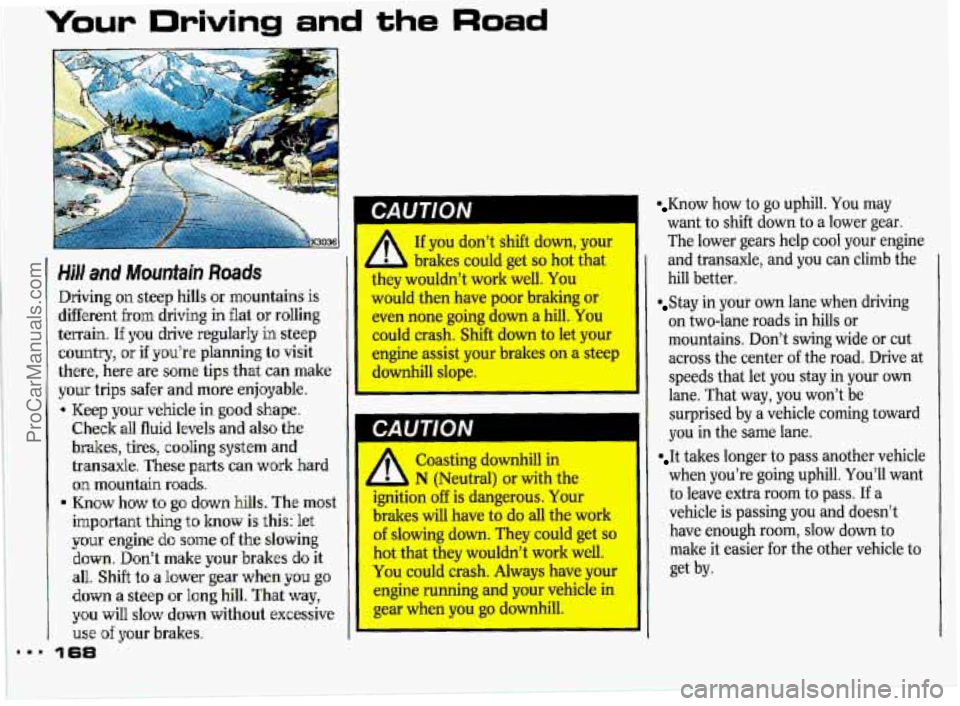
your Driving and the Road
-1
HM and Mountain Roads
Driving on steep hills or mountains is
different fiom driving in flat or rolling
terrain.
If you drive regularly in step
country, or if you’re planning to visit
there, here are some tips that can make
your trips safer and more enjoyable.
* Keep your vehicle in go’od shape.
Check all fluid levels and also the
brakes, tires, co’oling system and
transaxle. These
parts can work hard
~n mountain roads.
. K~QW how to go, down hills. The most
important thing
to how is this: let
your engine do some of the slowing
down. Don’t make your brakes do it
an.. Shift to a lower gear when YQU go
down a steep or long hill. That way,
you will slow down without excessive
use of your brakes.
168
If you don’t shift down, your
brakes could get
so hot that
they wouldn’t work well. You
would then have poor braking or
even none going down a hill.
You
could crash. Shift down to let your
engine assist your brakes on a steep
downhill slope.
I
A Coasting downhill in
- N (Neutral) or with the
* ignition off is dangerous. Your
akes will have
to do all the work
slowing down. They could get
so
riot that they wouldn’t work well.
You could crash. Always have your
Pngine running and your vehicle in
a-ar when you
go downhill.
Know how to go uphill. You may
want to shift down to a lower gear.
The lower gears help
cool your engine
and transaxle, and you can climb the
hill better.
Stay in your own lane when driving
on two-lane roads in hills or
mountains. Don’t swing wide or cut
across the center
of the road. Drive at
speeds that let you stay in your own
lane. That way, you won’t be ’ surprised by a vehicle coming toward
you in the same lane.
It takes longer to pass another vehicle
when you’re going uphill. You’ll want
to leave extra room to pass. If a
vehicle is passing you and doesn’t
have enough room, slow down to
make it easier for the other vehicle to
get by.
ProCarManuals.com
Page 172 of 338
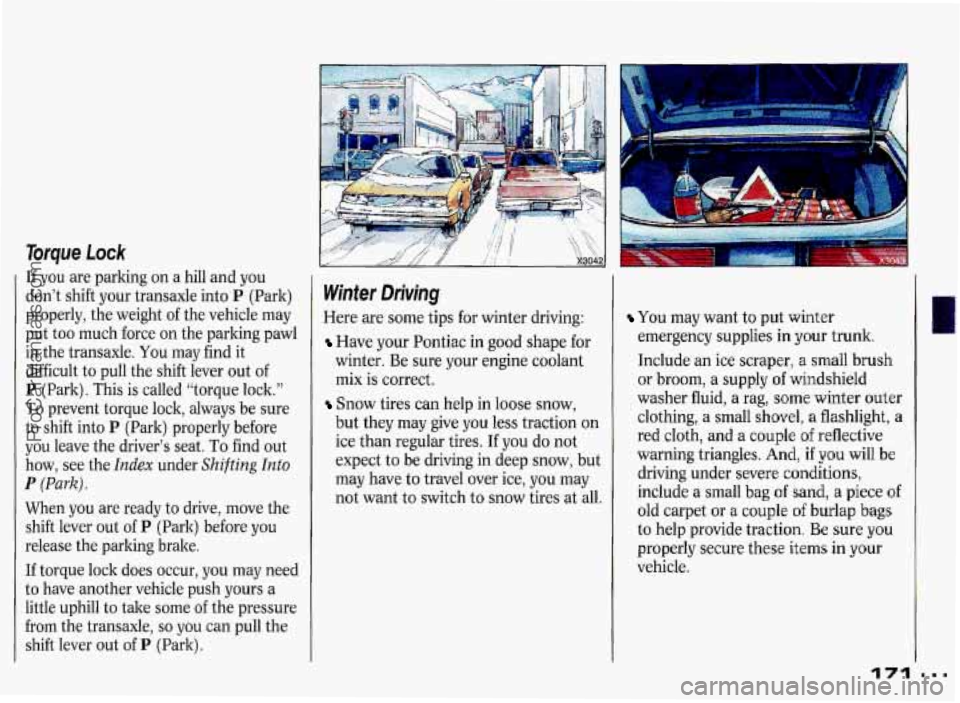
Torque Lock
If you are parking on a hill and you
don’t shift your transaxle into P (Park)
properly, the weight of the vehicle may
put too much force on the parking pawl
in the transaxle.
You may find it
difficult to pull the shift lever out of
P (Park). This is called “torque lock.”
To prevent torque lock, always be sure
to shift into
P (Park) properly before
you leave the driver’s seat. To find out
how, see the
lndex under Shifting Into
P (Park).
When you are ready to drive, move the
shift lever out
of P (Park) before you
release the parking brake.
If torque lock does occur, you may need
to have another vehicle push yours
a
little uphill to take some of the pressure
from the transaxle,
so you can pull the
shift lever out
of P (Park).
Winter Driving
Here are some tips for winter driving:
Have your Pontiac in good shape for
winter. Be sure your engine coolant
mix is correct.
Snow tires can help in loose snow,
but they may give
you less traction on
ice than regular tires. If you do not
expect to be driving in deep snow, but
may have to travel over ice,
you may
not want to switch to snow tires at all.
.. “I
. ..
You may want to put winter
emergency supplies
in your trunk.
Include an ice scraper, a small brush
or broom, a supply of windshield
washer fluid, a rag,
some winter outer
clothing, a small shovel,
a flashlight, a
red cloth, and a couple of reflective
warning triangles.
And, if you will be
driving under severe conditions,
include
a small bag of sand, a piece of
old carpet or a couple of burlap bags
to help provide traction. Be sure you
properly secure these items in your
vehicle.
171
ProCarManuals.com
Page 179 of 338
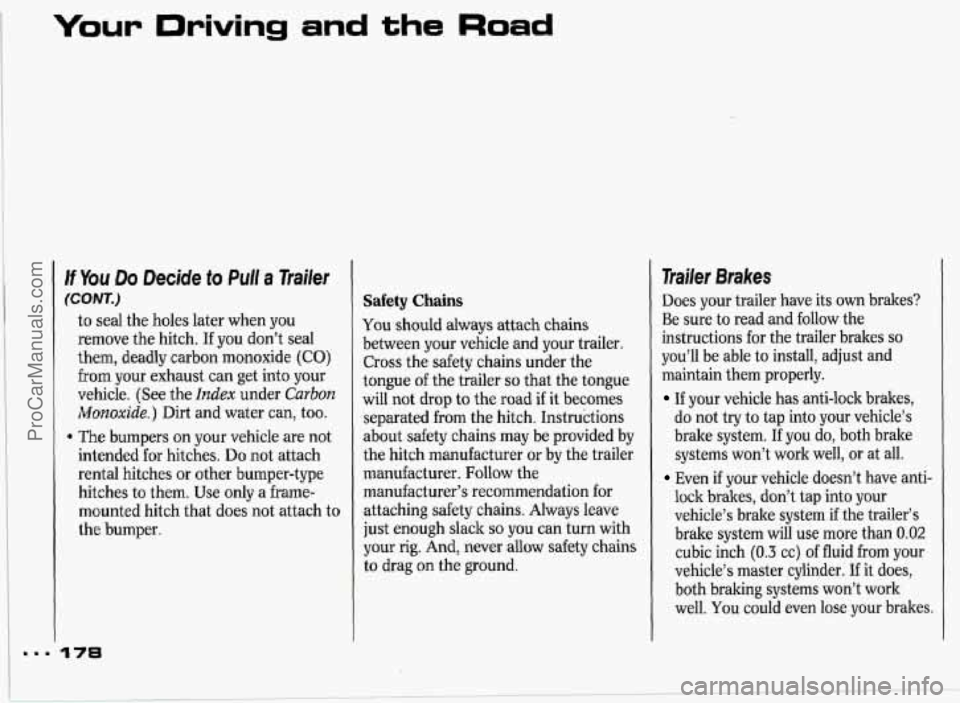
Your Driving and the Road
If You Do Decide to Pull a Trailer
(CONT.)
to seal the holes later when you
remove the hitch. If you don’t seal
them, deadly carbon monoxide
(CO)
from your exhaust can get into your
vehicle. (See the
Index under Carbon
Monoxide.) Dirt and water can, too.
4 The bumpers on your vehicle are not
intended for hitches.
Do not attach
rental hitches or other bumper-type
hitches to them. Use only a frame-
mounted hitch that does not attach to
the bumper.
Safety Chains
You should always attach chains
between your vehicle and your trailer.
Cross the safety chains under the
tongue of the trailer
so that the tongue
will not
drop to the road if it becomes
separated
from the hitch. Instructions
about safety chains may
be provided by
the hitch manufacturer
or by the trailer
manufacturer. Follow the
manufacturer’s recommendation for
attaching safety chains. Always leave
just enough slack
so you can turn with
your rig. And, never allow safety chains
to drag on the ground.
Trailer Brakes
Does your trailer have its own brakes?
Be sure to read and follow the
instructions for the trailer brakes
so
you’ll be able to install, adjust and
maintain them properly.
If your vehicle has anti-lock brakes,
do not try to tap into your vehicle’s
brake system.
If you do, both brake
systems won’t work well, or at all.
Even if your vehicle doesn’t have anti-
lock brakes, don’t tap into your
vehicle’s brake system
if the trailer’s
brake system will use more than
0.02
cubic inch (0.3 cc) of fluid from your
vehicle’s master cylinder. If it does,
both braking systems won’t work
well. You could even lose your brakes.
ProCarManuals.com
Page 180 of 338
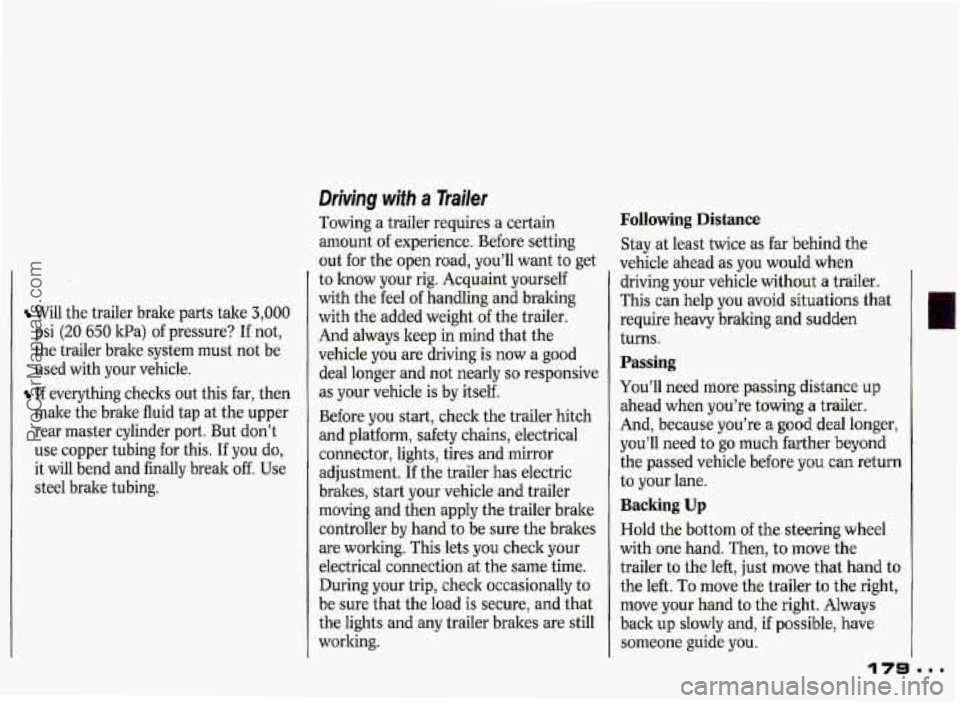
Will the trailer brake parts take 3,000
psi (20 650 1tPa) of pressure? If not,
the trailer brake system must not be
used with your vehicle.
If everything checks out this far, then
make the brake fluid tap at the upper
rear master cylinder port. But don’t
use copper tubing for this. If you do,
it will bend and finally break
off. Use
steel brake tubing.
Driving with a Trailer
Towing a trailer requires a certain
amount of experience. Before setting
out for the open road, you’ll want to get
to know your rig. Acquaint yourself
with the feel of handling and braking
with the added weight of the trailer.
And always keep in mind that the
vehicle you are driving is now a good
deal longer and not nearly
so responsive
as your vehicle is by itself.
Before you start, check the trailer hitch
and platform, safety chains, electrical
connector, lights, tires and mirror
adjustment. If the trailer has electric
brakes, start your vehicle and trailer
moving and then apply the trailer brake
controller by hand to be sure the brakes
are working. This lets
you check your
electrical connection at the same time.
During your trip, check occasionally to
be sure that the load is secure, and that
the lights and any trailer brakes are still
working.
Following Distance
Stay at least twice as far behind the
vehicle ahead as you would when
driving your vehicle without
a trailer.
This can help you avoid situations that
require heavy braking and sudden
turns.
Passing
You’ll need more passing distance up
ahead when you’re towing a trailer.
And, because you’re a
good deal longer,
you’ll need to
go much farther beyond
the passed vehicle before you can return
to your lane.
Backing Up
Hold the bottom of the steering wheel
with one hand. Then, to move
the
trailer to the left, just move that hand to
the left.
To move the trailer to the right,
move your hand to the right. Always
back up slowly and, if possible, have
someone guide you.
ProCarManuals.com
Page 182 of 338
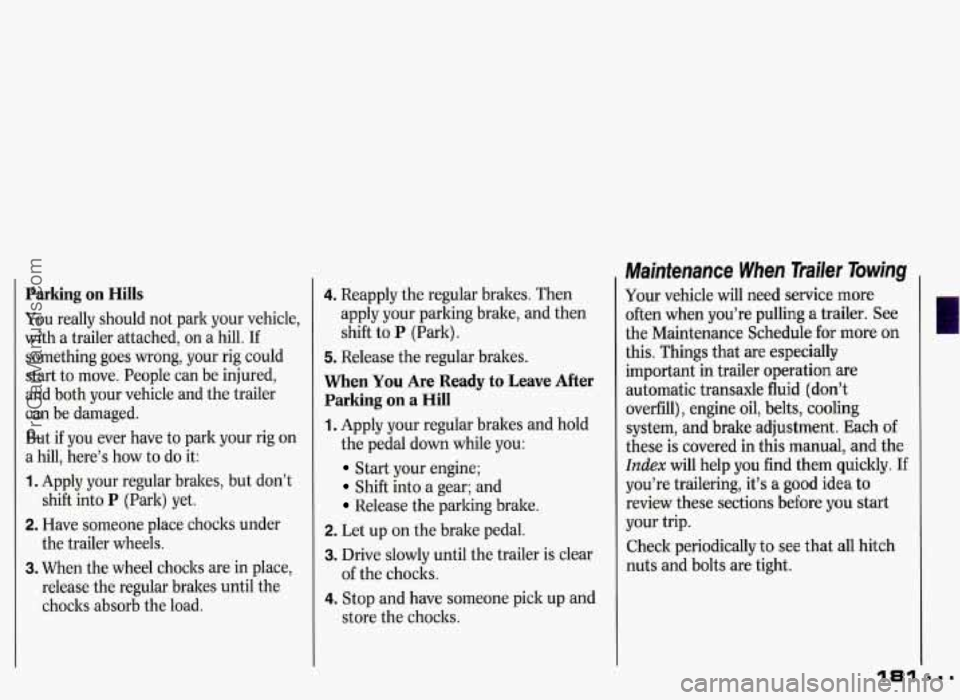
Parking on Hills
You really should not park your vehicle,
with a trailer attached, on a hill.
If
something goes wrong, your rig could
start to move. People can be injured,
and both your vehicle and the trailer
can be damaged.
But if you ever have to park your rig on
a hill, here’s how to do it:
1. Apply your regular brakes, but don’t
shift into
P (Park) yet.
2. Have someone place chocks under
the trailer wheels.
3. When the wheel chocks are in place,
release the regular brakes until the
chocks absorb the load.
4. Reapply the regular brakes. Then
apply your parking brake, and then
shift to
P (Park).
5. Release the regular brakes.
When You Are Ready to Leave After
Parking
on a Hill
1. Apply your regular brakes and hold
the pedal down while you:
Start your engine;
Shift into a gear; and
Release the parking brake.
2. Let up on the brake pedal.
3. Drive slowly until the trailer is clear
4. Stop and have someone pick up and
of
the chocks.
store the choclts.
Maintenance When Trailer Towing
Your vehicle will need service more
often when you’re pulling a trailer. See
the Maintenance Schedule for more on
this. Things that are especially
important in trailer operation
are
automatic transaxle fluid (don’t
overfill), engine oil, belts, cooling
system, and brake adjustment. Each
of
these is covered in this manual, and the
Index will help you find them quickly. If
you’re trailering, it’s a good idea to
review these sections before you start
your trip.
Check periodically to see that all hitch
nuts and bolts are tight.
IBI ...
ProCarManuals.com
Page 212 of 338
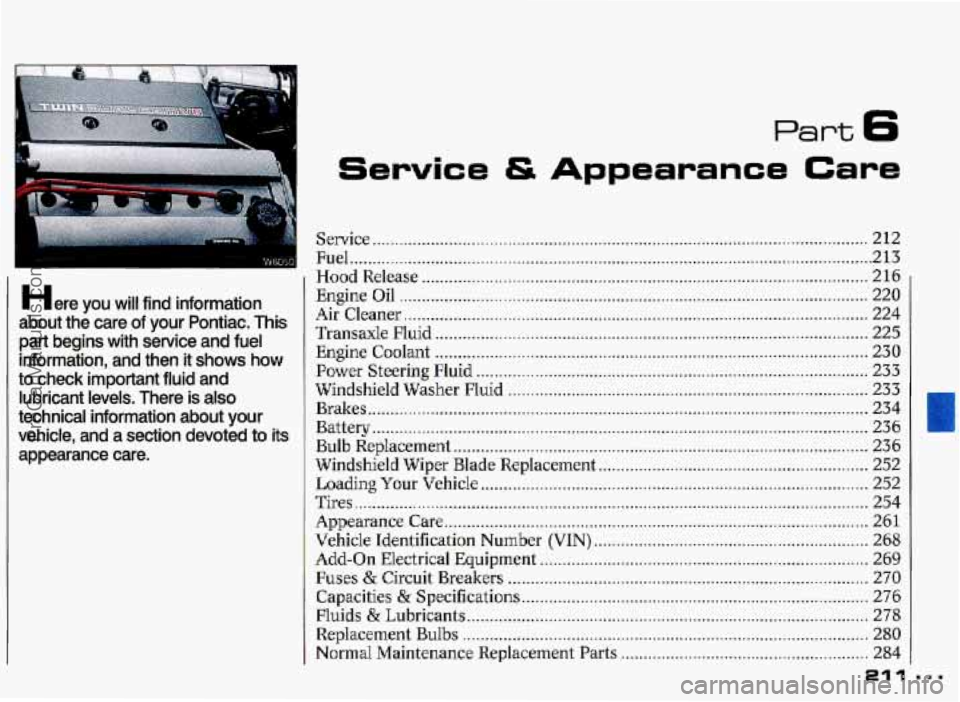
Part 6
Here you will find information
about the care
of your Pontiac . This
part begins with service
and fuel
information. and then it
shows how
to check important fluid and lubricant levels
. There is also
technical information about your
vehicle. and a section devoted
to its
appearance care
.
81 1
Service & Appearance Care
Service ........................................................................\
...................................... 212
Fuel ........................................................................\
............................................ 213
Hood Release ........................................................................\
............................ 216
Engine Oil
........................................................................\
................................ 220
Air Cleaner ........................................................................\
............................... 224
Transaxle
Fluid ........................................................................\
........................ 225
Engine Coolant ........................................................................\
........................ 230
Power Steering Fluid ........................................................................\
............... 233
Windshield Washer
Fluid ........................................................................\
........ 233
Brakes
.......... .......................... ........................................................................\
... 234
Battery
........................................................................\
........................ .... .......... 236
Bulb Replacement ........................................................................\
.................... 236
Loading
Your Vehicle ........................................................................\
.............. 252
Vehicle Identification Number (VIN) ............................................................. 268
Capacities
& Specifications ........................................................................\
..... 276
Replacement
Bulbs ................................................................... .......- ............... 280
Windshield Wiper
Blade Replacement ............................................................ 252
Tires ........................................................................\
.......................................... 254
Appearance Care ........................................................................\
...................... 261
Add-on Electrical Equipment ........................................................................\
. 269
Fuses & Circuit Breakers ........................................................................\
........ 270
Fluids
& Lubricants ........................................................................\
................. 278
Normal Maintenance Replacement Parts ....................................................... 284
ProCarManuals.com
Page 218 of 338
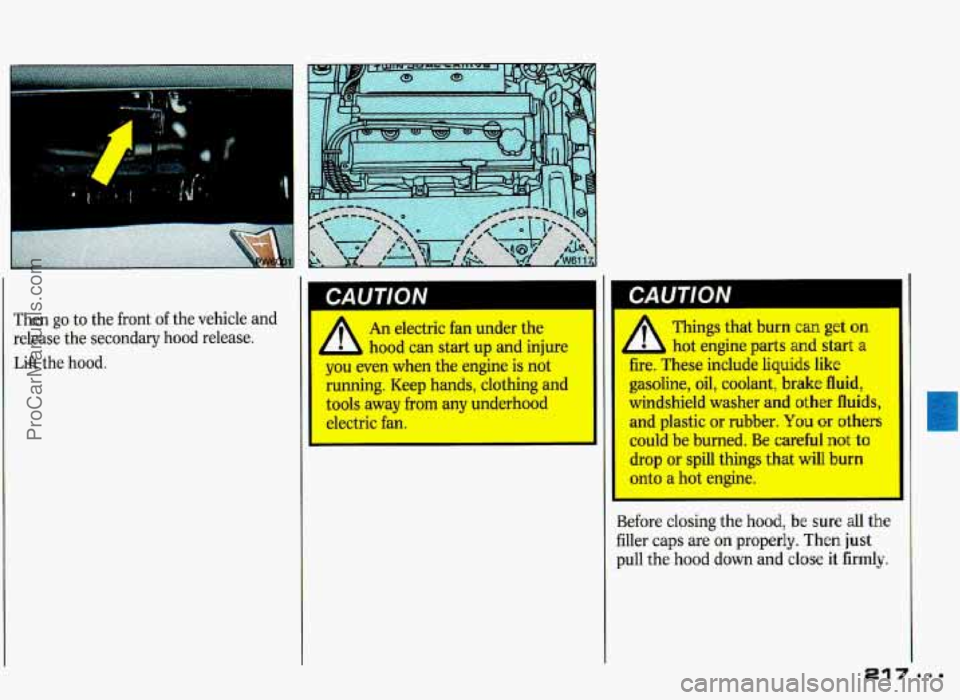
I
I
Then go to the front of the vehicle and
release the secondary
hood release.
Lift the hood.
CAUTION I
A
An electric fan under the
hood can start up and injure
you even when the engine is not
running. Keep hands, clothing and
tools away from any underhood
electric fan.
I-
I
CAUTION
fire. These include liquids like
gasoline, oil, coolant, brake fluid,
windshield washer and other
fluids,
and plastic or rubber. You or others
could be burned. Be
careful not to
drop or spill things that will burn
onto a hot engine.
Before closing the hood,
be sure all the
filler caps are on properly. Then
just
pull the hood down and close it firmly.
A
Things that burn can get on I
hot engine parts and start a
ProCarManuals.com
Page 219 of 338
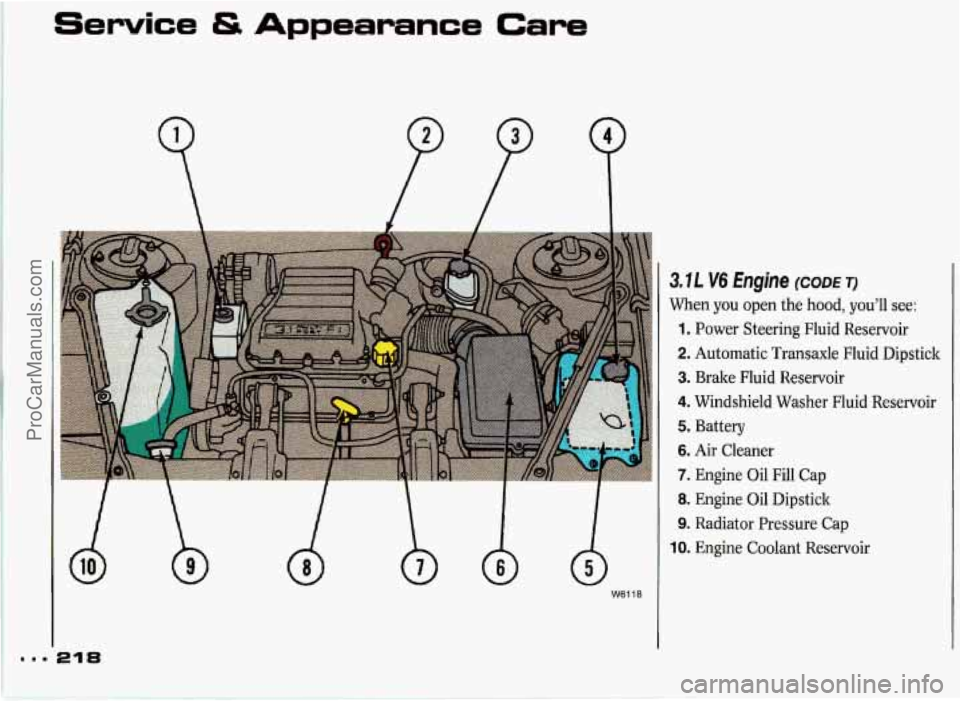
Service & Appearance Care
21%
W6118
3.IL V6 Engine (CODE T)
When you open the hood, you’ll see:
1. Power Steering Fluid Reservoir
2. Automatic Transaxle Fluid Dipstick
3. Brake Fluid Reservoir
4. Windshield Washer Fluid Reservoir
5. Battery
6. Air Cleaner
7. Engine Oil Fill Cap
8. Engine Oil Dipstick
9. Radiator Pressure Cap
10. Engine Coolant Reservoir
ProCarManuals.com
Page 220 of 338
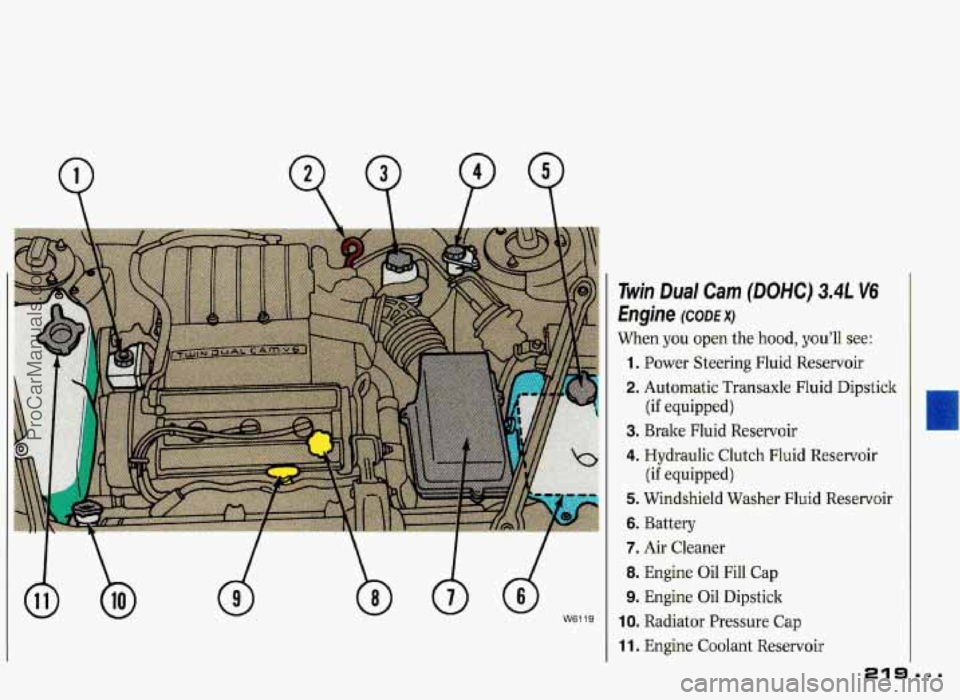
d
Twin Dual Cam (DOHC) 3.4L V6
hgne (CODE x)
When you open the hood, you’ll see:
1. Power Steering Fluid Reservoir
2. Automatic Transaxle Fluid Dipstick
3. Brake Fluid Reservoir
4. Hydraulic Clutch Fluid Reservoir
5. Windshield Washer Fluid Reservoir
6. Battery
7. Air Cleaner
8. Engine Oil Fill Cap
9. Engine Oil Dipstick
IO. Radiator Pressure Cap
11. Engine Coolant Reservoir
(if equipped)
(if equipped)
ProCarManuals.com